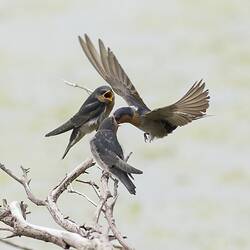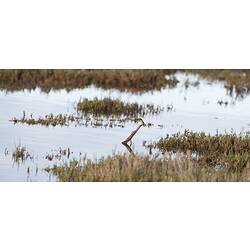General Description
Upper body parts shiny blue-black with forehead and throat rusty brown. Underparts grey-white. Wings grey and tail darker grey with some white markings. Tail deeply forked. Bill, legs and eyes are dark. Bill to tail length is up to 15 cm.
Biology
Welcome Swallows feed on a wide variety of insects. They are acrobatic birds and catch their prey in flight. The birds are partly nomadic, moving in response to the availability of their prey. Large flocks are common in coastal areas. Welcome Swallows build a cup-shaped nest out of mud and grass. It is attached to a solid structure such as the wall of a cave or a building. The breeding season is between August and February and a pair may raise two broods during this time.
Distribution
Mainland Australia and Tasmania.
Habitat
Most areas.
More Information
-
Animal Type
-
Animal SubType
-
Brief Id
A small acrobatic, blue-black bird with a rusty coloured face, dull white belly and a forked tail.
-
Colours
Blue, Black, White, Rufous
-
Maximum Size
15 cm
-
Habitats
Coastal shores, Wetland, Urban, DryForest, WetForest, Woodland, Mallee, Grassland
-
Diet
Insects
-
Diet Categories
Insects
-
Endemicity
-
Commercial
No
-
Conservation Statuses
CITES: Not listed, FFG Threatened List: Not listed, EPBC Act 1999: Not listed, IUCN Red List: Least Concern
-
Depths
Shore (0-1 m)
-
Water Column Locations
Above surface
-
Taxon Name
-
Common Name
Welcome Swallow
-
Kingdom
-
Phylum
-
Subphylum
-
Class
-
Order
-
Family
-
Genus
-
Species Name
neoxena










